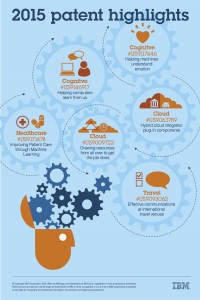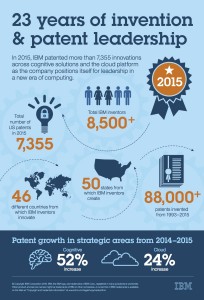Big Data
Inside IBM: The Inventors Who Are Creating the Era of Cognitive Computing
January 13, 2016 | Written by: Steve Hamm
Categorized: Big Data | Cloud Computing | Cognitive Computing | Data Analytics | High Performance Computing | IBM Research | IBM Watson | Mobile Computing | security | Social Business
Share this post:
How many times have you been raving about a great movie and, suddenly, you draw a blank on the star actor’s name? Don’t worry, it happens to everybody. Well, in the not-too-distant future, when you get hung up, you may get a timely assist from a computer—one smart enough to complete your sentences for you.
Or, on a more serious note, consider the problems confronted by people with Alzheimer’s, dementia or other cognitive impairments. They often find themselves confused and at a loss for words. What if a computer could finish their thoughts for them—or even help them complete a task like getting dressed or fixing breakfast?
Both of these scenarios are addressed by a new cognitive technology conceived of by three IBMers who were inspired by their desire to help people who suffer from Alzheimer’s. “We talked about how disturbing these problems are for people, and we realized that cloud-based cognitive technologies could make a big difference,” says James Kozloski, an IBM Research scientist who developed the idea along with colleagues Irina Rish and Clifford Pickover.
The invention landed them one of 7,355 patents that IBMers were awarded last year by the US Patent & Trademark Office—a tally that for the 23rd consecutive year ranked IBM as the world’s most innovative company.
IBM’s work in cognitive computing emerged as a major factor last year. More than 800 of IBM’s 2015 patents are related to cognitive computing, a 52% increase from the previous year.
IBM has realigned its entire business strategy around the promise of cognitive computers, which can learn, reason, and efficiently process diverse data types all while interacting with people in natural and familiar ways. These technologies are designed to augment human intelligence—potentially transforming industries, professions, and, ultimately, all of society.
The rapid rise of cognitive computing, along with exciting advances in cloud, analytics, data security, and mobility, have unleashed an outpouring of creativity among IBM’s scientists and engineers. IBM Research has 3,000 professionals in 12 labs around the world, and the company employs 10s of thousands of software programmers, hardware engineers and industry-focused consultants. From that deep pool of talent, 8,500 IBMers landed US patents last year. They live all over the place–50 states and US territories and 46 countries. IBM inventors who reside outside the United States contributed to more than 36% of the 2015 patents.
 James Kozloski recalls that the memory assistance invention emerged when he, Irina and Cliff were batting around ideas at a table in the cafeteria at the IBM Research lab in Yorktown, N.Y. The three schedule regular meetings there to cross-pollinate and brainstorm innovations. On this day, they were thinking about new enhancements for the IBM Watson question answering technology—and they knew people with Alzheimer’s. Why not use Watson to help deal with that? Says James: “This is a great example of how inventors can take what is obviously going to be a major innovation and use their own expertise to take it in a new direction.”
James Kozloski recalls that the memory assistance invention emerged when he, Irina and Cliff were batting around ideas at a table in the cafeteria at the IBM Research lab in Yorktown, N.Y. The three schedule regular meetings there to cross-pollinate and brainstorm innovations. On this day, they were thinking about new enhancements for the IBM Watson question answering technology—and they knew people with Alzheimer’s. Why not use Watson to help deal with that? Says James: “This is a great example of how inventors can take what is obviously going to be a major innovation and use their own expertise to take it in a new direction.”
The idea is to combine a handful of technologies, including machine learning and Bayesian reasoning, to create a highly sophisticated app that understands the user and their environment and detects when they’re struggling with expressing themselves or with getting a task done. The system will create a hypothesis about what the person means to say or do next in a particular context. Then it will suggest words or sentences, or will prompt the person to take the next step in their task.
You can also imagine this kind of capability being used to help just about anybody when they suffer a memory freeze—like forgetting that actor Kevin Spacey played the sly criminal mastermind Keyser Soze in The Usual Suspects.
For James, inventing is second nature. A scientist in IBM Research’s computation and applied neuroscience group, he has landed 37 patents in his 15 years at IBM—helping him to achieve the designation of IBM Master Inventor.
On the other end of the spectrum of experience among IBM inventors is Jeremy Greenberger, who turned 24 on Monday. He was not yet born when IBM began its unprecedented record of patent leadership.

IBM software engineer Jeremy Greenberger sketches out a patent he has pending. (Jared Lazarus/Feature Photo Service for IBM)
Jeremy came to IBM just 1 ½ years ago with a freshly-minted BS in computer science from the University of South Carolina. But, already, he’s making his mark as a prodigious ideas man. He has submitted 60 invention ideas for internal IBM review, of which 18 have so far been approved for patent applications and 6 have been submitted to the US PTO.
Jeremy was fascinated with both technology and business starting as a teenager growing up in northern New Jersey. He and his father, a dentist, started their own company on the side when he was 16—a digital advertising business. He hadn’t decided for sure that what he really wanted to do was be an inventor until he arrived at IBM’s offices in Durham, North Carolina, and started working on mobile and cloud technologies. All around him, people had hung plaques on their cubicles commending them for their patents. He wanted that for himself.
He credits a couple of IBM Master Inventors for helping him learn the ropes; first John Gerken, and, later, Lisa Seacat Deluca, who has more than 150 patents and is IBM’s most prolific female inventor ever.
He can remember the day, Feb. 24, 2015, when he got received his first notification that IBM planned on filing a patent application for one of his inventions. “I was so excited,” he says. “I looked at the document and thought: ‘This is my idea, and it could help change the world!’”
Now Jeremy is on fire. His goal is nothing less than to become the youngest-ever IBM Master Inventor. By his calculations, he has a little over two years in which to make it.
Even though James Kozloski has 15 years at IBM under his belt, he’s no less enthusiastic than Jeremy about the potential for innovation here. His PhD was in neuroscience and he has been focusing in recent years on modeling the human brain. There have been tremendous advances in neuroscience and computational biology over the past decade, and, now, the two branches of science are fast converging—with tremendous implications, including the ability to develop sophisticated cognitive assistants for human beings.
“Research is for people who have the patience to explore the big questions,” James says. “We’re the stubborn ones who want to find the answers and to make the big changes in the world.”
—-
To learn more about the new era of computing, read Smart Machines: IBM’s Watson and the Era of Cognitive Computing.
Meet the Newest IBM Fellows
Since the first class of IBM Fellows in 1962, IBM has honored its top scientists, engineers and programmers, who are chosen for this distinction by the CEO. Among the best and brightest of IBM’s global workforce are 12 new IBM Fellows who join 293 of their peers who have been so recognized over the last […]
Accelerating Digital Transformation with DataOps
Across an array of use cases, AI pioneers are employing a core set of new AI capabilities to unlock the value of data in new ways. According to the 2019 IBM Global C-suite study, leaders are using data 154% more to identify unmet customer needs, enter new markets, and develop new business models. These leaders […]
How IBM is Advancing AI Once Again & Why it Matters to Your Business
There have been several seminal moments in the recent history of AI. In the mid-1990s, IBM created the Deep Blue system that played and beat world chess champion, Garry Kasparov in a live tournament. In 2011, we unveiled Watson, a natural language question and answering system, and put it on the hit television quiz show, […]




